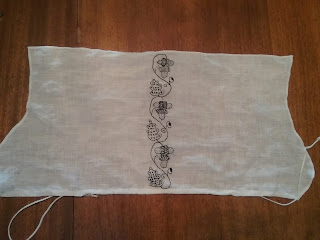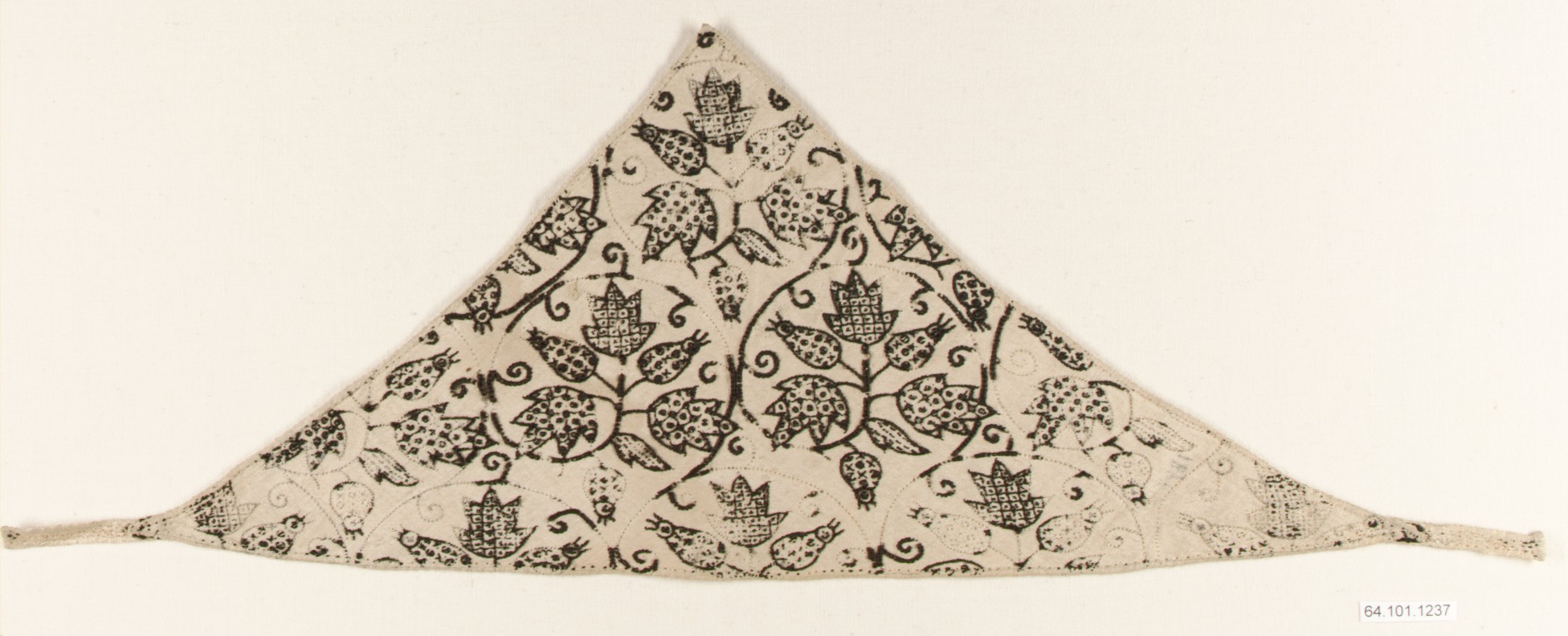 |
| One column down, "2(/2) and 6" to go. |
And the coif embroidery commences. The garment itself is based on original coifs dated c.1590-1620 in Patterns of Fashion 4 (it's specifically this coif, though the hair-dressing was less wrong in the version with lace).
The design I selected is an oak-leaf and acorn motif from A Schole-House For the Needle (1624, some designs as early as 1540s). The book only gives the figures themselves, leaving it to the embroiderer to determine stitches and fill effects. I therefore consulted Elizabethan Stitches by Jacqui Carey for insight into the stitches and how to apply them. While full of lovely examples, and very detailed analysis, all of the original coifs in the book were covered in polychrome embroidery, many with metallic accents. This has given me a lot of ideas about the next coif I hope to attempt--using the wider braided stitches for the vine-like pattern elements and dense infilling of the motifs--but it isn't the single-color, more delicate blackwork effect I want for this project.
The aesthetic I'm looking at is more like this coif and matching forehead cloth in the Met, where the lines are fairly narrow, and the infilling is pretty open (quite suitable for differentiating space in monochromatic floss):
| Late 16th century blackwork coif in The Met. |
 |
| A matching forehead cloth, with good close-up images of the stitching. |
In addition to the possibly-chain-stitched outline, the Met coif uses a variety of open filling patterns. The largest leaf motifs have square or diamond grids of a narrow stitch, with dots in the voids (and on the nodes of the diamonds); the fruit/flower element has alternating Xs and Os; and the smallest leaves have rows of parallel dotted lines (suggesting a running or half backstitch).
I decided to copy the squirrel smock and use a stem stitch for the vines and outlines. I borrowed the Met coif's alternating 'noughts & crosses' on the oak leaves, with its broken line pattern on the acorns to suggest the lines on a real one. For the acorns caps, I initially tried infilling the whole cap with a detached buttonhole stitch (from Elizabeth Stitches), but even on such a small area, the effect was too dark. I decided against using a herringbone or other dense space-filling stitch for the same reason. The second method I tried was using spaced Xs in reference to the crosshatched texture of an acorn cap. This worked a bit better, but didn't quite capture the true look of an acorn, while also not affording as much contrast as I would like between the caps and the other parts of the design. At that point, I decided to attempt a diamond grid, like the Met coif (but set closer and thus without the dots). I expected a backstitch to get too messy (it's not my best), and so made each diagonal a whole stitch (tacked at the intersections so the floats won't catch as easily). As far as I know, this is my own invention, but it gives neat, reasonably strong straight lines with minimal waste of silk on the verso, so I think it's in the spirit of the 16th-17th century at least. The buds or immature acorns have chainstitch infilling.
 |
| Another thing I learned: changing stitches until you get one you like is apparently a-ok in this sort of work. |
The fabric is IL020 (3.5 oz handkerchief weight linen) from Fabric-store.com; the thread is Soie d'Alger seven-strand silk floss from Needle In A Haystack. Even the single strand I'm using looks too heavy up close on the linen, so I'm tempted to try my next overly ambitious embroidery project on the IC64 'luxury' mid-weight. It's fine, but a bit denser, and should make up very nicely
No comments:
Post a Comment
Thanks for commenting!